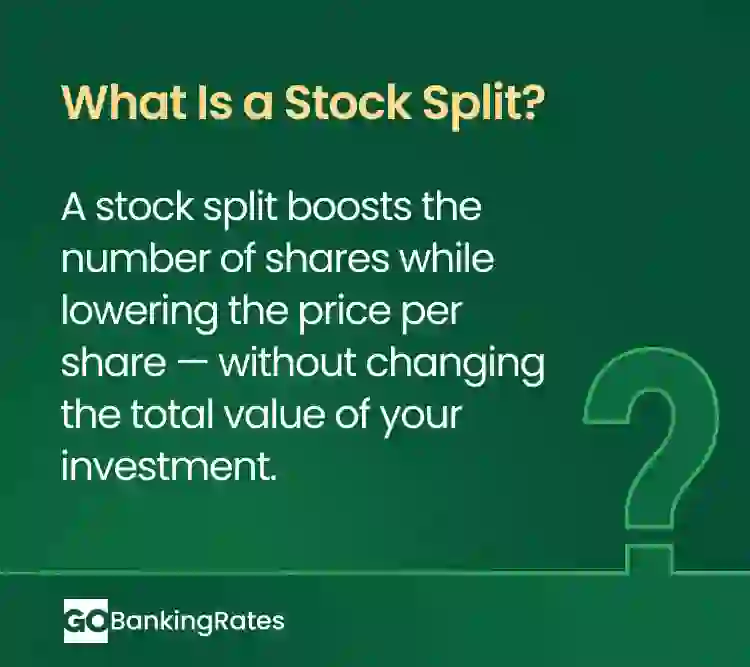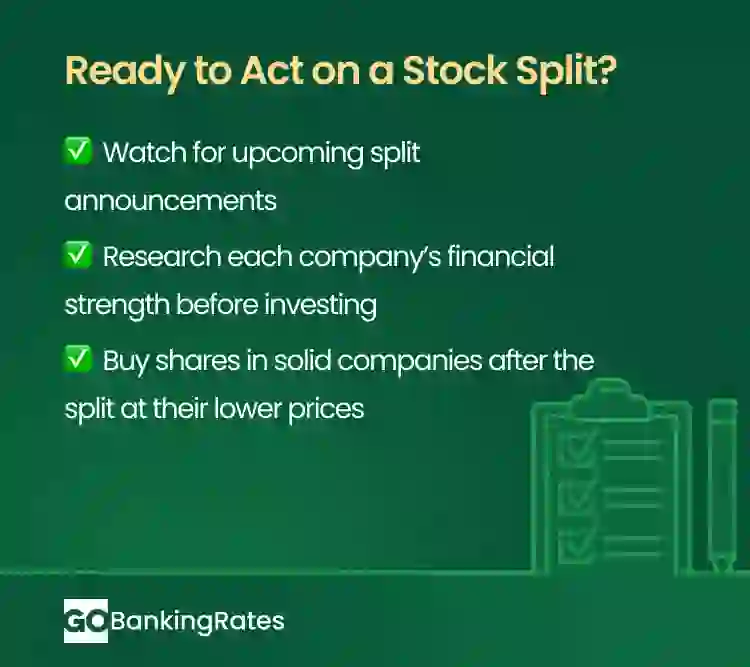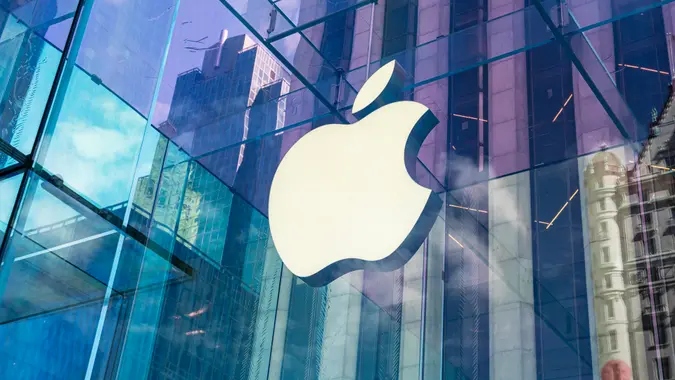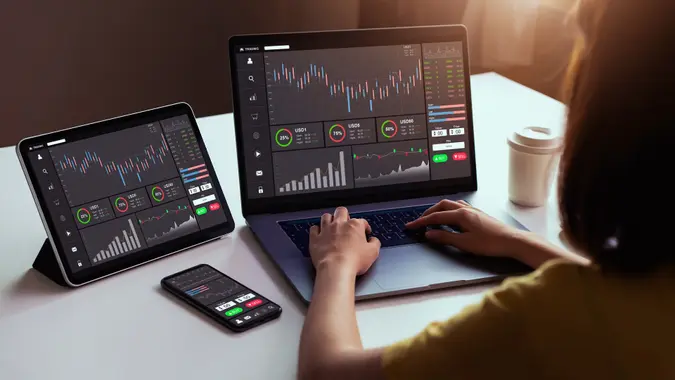What Is a Stock Split? How It Works and Why It Matters

Commitment to Our Readers
GOBankingRates' editorial team is committed to bringing you unbiased reviews and information. We use data-driven methodologies to evaluate financial products and services - our reviews and ratings are not influenced by advertisers. You can read more about our editorial guidelines and our products and services review methodology.

20 Years
Helping You Live Richer

Reviewed
by Experts

Trusted by
Millions of Readers
Sometimes, companies want to make their stock more affordable, attractive or accessible to investors without lowering the collective value of their shares. They achieve this through stock splits — or, if they want to increase the price, reverse stock splits. Here’s a look at how stock splits work, and why they matter.

How a Stock Split Works
If a company determines that its stock price is too high, it can lower the value of each share by increasing the number of outstanding shares through an action called a stock split.
For example, suppose XYZ Corp.’s stock is selling at $1,000 per share. The company thinks that’s too pricey, so the board approves a 2-for-1 stock split. Here’s what happens:
- The company grants each shareholder an additional share for each share they already own.
- The value of each share is cut in half to $500 each since there are now twice as many shares.
The following table shows how that would affect you if you had $100,000 worth of shares.
| Shares/Value | Before Split | After Split |
|---|---|---|
| Number of shares | 100 | 200 |
| Price per share | $1,0000 | $500 |
| Total investment value | $100,000 | $100,000 |
Types of Stock Splits
There are a few types of stock splits.
- Forward 2-for-1 (2:1): These stock splits are the most common. They occur when a company doubles the number of outstanding shares and lowers stock prices by half.
- Forward 4-for-1 (4:1): This type divides each share into quarters, with each share now worth a quarter of the value of the original.
Here are some examples of forward splits from the last few years.
| Company Name | Split Ratio | Split Date | Price Before Split | Price After Split |
|---|---|---|---|---|
| GameStop | 4:1 | July 22, 2022 | $158.75 | $38 |
| Tesla | 3:1 | Aug. 25, 2022 | $891.29 | $302 |
| Walmart | 3:1 | Feb. 26, 2024 | $175.56 | $58.52 |
A reverse split works in the opposite way, reducing shares and proportionately increasing the price per share.
Reverse Stock Splits and Their Effects
When a stock price gets too low, it can also be a problem for companies. To fix this, they may do a reverse stock split — trading several low-priced shares for one share at a higher price. Common reasons include:
- Boost the share price to comply with stock exchange price minimums
- Entice investors turned off by low share prices to buy stocks
An example of a reverse split occurred in 2003, when Priceline.com, now known as Booking Holdings, went through a 1-to-6 reverse stock split, going from roughly $4 a share to about $25 a share. It seems to have worked out — Booking Holdings closed at $5,548 on Sept. 26.
Key Differences Between Types of Stock Splits
Here’s a side-by-side look at the difference between forward and reverse splits.
| Stock Split Type | Purpose | Impact on No. of Shares | Impact on Share Price | Impact on Market Cap | Typical Use Cases |
|---|---|---|---|---|---|
| Forward | Increase shares | Increases by split ratio | Decreases by split ratio | None | -Make share more accessible -Increase liquidity -Keep share price competitive |
| Reverse | Decrease shares | Decreases by split ratio | Increases by split ratio | None | -Avoid delisting from stock exchange -Attract investors looking for quality shares |
Why Do Companies Split Their Stock?
Companies conduct stock splits for a few reasons:
- Make stock more affordable: Lowering the price per share makes it easier for everyday investors to buy in.
- Increase liquidity: More shares on the market mean faster, more efficient trading, which can help reduce risk.
- Boost market perception: Stock splits can generate excitement, media coverage and attract new investors.
Impact on Shareholder Value
Stock splits have no direct effect on shareholder value. Shareholders have the same amount of money invested in the stock after the split as they had before the split. However, the split might have indirect impacts.
- Before the split: Share prices often rise after the announcement, but the boost is usually temporary unless the company’s long-term performance supports it.
- After the split: Prices can climb again because some investors see a split as a sign of the company’s confidence — a “management-signaling effect,” according to Chase.
Stock Split vs. Stock Dividend
From the perspective of an individual shareholder, a stock dividend is very similar to a stock split. In fact, the only real difference is in how it is accounted for on a company’s books.
Here’s how stock splits and stock dividends compare.
| Type of Corporate Action | How It’s Accomplished | Purpose | Effect on Market Price | Effect on Shareholder Ownership | Accounting Treatment |
|---|---|---|---|---|---|
| Stock split | Division of existing shares in the marketplace | Drives liquidity and investor interest and accessibility | Drops in the same proportion as split | Shareholders retain the same dollar amount of stock | No impact on retained earnings |
| Stock dividend | Additional shares distributed to stockholders | Reward to existing shareholders | Drops by percentage of the stock dividend | Shareholders retain the same dollar amount of stock | Transferred from retained earnings to paid-in capital |
The Impact of Stock Splits on Shareholders
A company’s value on the stock market is determined by its market capitalization. This metric represents the combined value of all the company’s shares. Although a stock split changes both the price and the number of a company’s shares, the combined value of those shares — the company’s market cap — always remains the same.
A stock split often means the company’s share price has grown so much that it has become too expensive for many investors. When the split makes shares more affordable, new investors are eager to buy in.
While a stock split technically doesn’t add or remove value, it can be good for the company and the shareholder who couldn’t have afforded a share otherwise.
It’s common for news of a stock split to trigger rapid gains. Kiplinger points to three main reasons why:
- Lower prices attract more buyers: Splits open the door to investors who were previously priced out, boosting demand — and prices.
- Confidence in continued growth: Investors often see a split as a sign that the company’s strong performance will continue.
- Signal to big investors: Companies sometimes use splits to show deep-pocketed investors that they have untapped growth potential, leading to large purchases in a short period.
Despite these benefits, not all companies split their stock. Growth companies often see rising share prices as proof of success and prefer to let them keep climbing.
Examples of Notable Stock Splits
When it comes to stock splits, some companies go really big, flooding the market with cheap shares.
Amazon split its shares 20:1 in 2022, as did Alphabet. Both had had previous splits. Shopify enacted a 10:1 split that same year.
Here are a couple of other stock splits that attracted a lot of attention.
Apple
In 2014, Apple split its stock 7-for-1 to bring the price from about $140 a share to about $20 a share. Six years later, the stock split again, this time at a 4-to-1 ratio. In all, Apple has split its stock five times in its history.
Tesla
In 2020, Tesla split its stock 5-to-1. This cut the electric car maker’s share price from about $2,250 per share to about $450 per share. It had more than doubled by the August 2022 3:1 split.
Historical Stock Split Timeline
- 1987: Apple splits 2:1
- 1998: Amazon splits 2:1
- 1999: Amazon splits 3:1 in January and 2:1 in September
- 2000: Apple splits 2:1
- 2005: Apple splits 2:1
- 2014: Apple splits 7:1, Alphabet splits 2:1
- 2020: Tesla splits 5:1, Apple splits 4:1
- 2022: Amazon splits 20:1, Alphabet splits 20:1, Shopify splits 10:1, Tesla splits 3:1
Stock Split Risks and Considerations
A stock split is neither good nor bad. It is a purely cosmetic corporate undertaking that does not impact the value of the stock, either to the company or to shareholders — at least on paper. But it can have positive and negative indirect effects.
Pros
- Pre-split boost: Share prices often rise after a forward split is announced, though the gain is usually priced in by the split date.
- Post-split bump: Prices can climb again after the split.
- Exchange compliance: Reverse splits can help companies meet minimum share price requirements to avoid delisting.
- Investor attention: Splits may attract analysts and major investors.
- More buyers: Lower share prices can encourage more people to invest.
Cons
- Financial trouble signal: Reverse stock splits often indicate a company may be struggling.
- Short-lived gains: Split-related price increases rarely last unless the company’s fundamentals support them.
What the Experts Say
MorningStar’s 2024 analysis looked at S&P 500 stocks that had split within the past one to 10 years. It then compared the one-year post-split returns of 54 such stocks to the overall S&P 500’s returns.
Here’s how the share prices fared:
- 18 increased by 0.1% to 20%
- 16 increased by 21% or more
- 12 decreased by 0.1% to 15%
- 8 decreased by 15% or more
Failing to identify a trend, MorningStar concluded that stock splits are “just cosmetic.”
“A split does not change the economic value of a company; it only changes the proportionate amount of ownership each share represents,” said Morningstar chief U.S. market strategist Dave Sekera.
Final Take
While splits don’t make companies more valuable, they do represent a window of opportunity for budget-minded investors whose brokerages don’t support fractional-share investing.
Want to make the most of a stock split? Follow these steps to find opportunities and invest wisely.

Stock Split FAQs
Even though stock splits are fairly simple, investors often have questions about how they work and when to act.- Are stock splits good for investors?
- Stock splits can benefit budget-minded and beginner stock investors who don't have access to fractional-share investing and can't afford to buy whole shares.
- Why would a company do a reverse split?
- A company might do a reverse split to raise share prices enough to comply with stock exchange share price minimums, or to entice investors turned off by cheap stocks.
- How often do stock splits happen?
- They happen occasionally. Some companies have split their stock several times. Others never have.
- Should I buy before or after a stock split?
- Prices increase most after the split is announced, so you could overpay if you base your investing decision on the split. The split shouldn't influence your decision over whether or not, or when, to invest.
Andrew Lisa and Karen Doyle contributed to the reporting for this article.
Information is accurate as of Sept. 29, 2025.
Our in-house research team and on-site financial experts work together to create content that’s accurate, impartial, and up to date. We fact-check every single statistic, quote and fact using trusted primary resources to make sure the information we provide is correct. You can learn more about GOBankingRates’ processes and standards in our editorial policy.
- Walmart. 2024. "Walmart Announces 3-for-1 Stock Split."
- Hartford Funds. "10 Things You Should Know About Stock Splits."
- Amazon. "FAQs."
- Reuters. 2024. "Tesla shares close lower after 3-1 stock split."
- Investor Place. 2022. "GME Stock Starts Trading at $38 Following GameStop Stock Split."
- Investor.gov. "Reverse Stock Splits."
- Chase. 2024. "Understanding stock splits."
- Kiplinger. 2024. "What Is a Stock Split and Why It Matters To Investors."
- Morningstar. 2024. "Do Stock Splits Really Matter?"
 Written by
Written by  Edited by
Edited by 
























